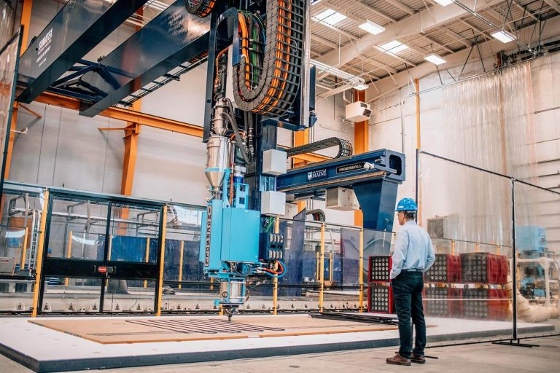 |
| June 11, 2024 | Volume 20 Issue 22 |
Designfax weekly eMagazine
Archives
Partners
Manufacturing Center
Product Spotlight
Modern Applications News
Metalworking Ideas For
Today's Job Shops
Tooling and Production
Strategies for large
metalworking plants
World record: Largest polymer 3D printer makes parts and structures almost 100 ft long
The University of Maine (UMaine) recently unveiled a next-generation polymer 3D printer that is the biggest in the world. The new machine is four times larger than its UMaine predecessor, which captured the Guinness World Record in 2019. The latest huge machine was made with the aim of supercharging the future of sustainable manufacturing in a number of industries.

UMaine's giant Future 1.0 3D printer doesn't just print polymers at a rate of 500 lb/hr; it can also dynamically switch between various processes such as large-scale additive manufacturing, subtractive manufacturing, continuous tape layup, and robotic arm operations. [Credit: UMaine Advanced Structures and Composites Center]
The new printer, dubbed Factory of the Future 1.0 (FoF 1.0), was unveiled on April 23 at UMaine's Advanced Structures and Composites Center (ASCC) to an audience that included representatives from the U.S. Department of Defense, U.S. Department of Energy, the Maine State Housing Authority, industry partners, and other stakeholders who plan to use this technology.
The thermoplastic polymer printer is designed to print objects as large as 96 ft long by 32 ft wide by 18 ft high, and it can print up to 500 lb per hour. Its developers say it offers new opportunities for eco-friendly and cost-effective manufacturing for numerous industries, including national security, affordable housing, bridge construction, ocean and wind energy technologies, and maritime vessel fabrication. The design and fabrication of this world-first printer and hybrid manufacturing system was made possible with support from the Office of the Secretary of Defense through the U.S. Army Corps of Engineers.
According to UMaine, FoF 1.0 isn't merely a gargantuan printer; it dynamically switches between various processes such as large-scale additive manufacturing, subtractive manufacturing, continuous tape layup, and robotic arm operations. Access to it and MasterPrint, the ASCC's first world-record-breaking 3D printer, will streamline manufacturing innovation research at the center. The two large printers can collaborate by sharing the same end-effectors or by working on the same part.
---------------------------
Want to see the printer in action? FOX ABC Maine has the reveal video here.
---------------------------
"UMaine and the Advanced Structures and Composites Center possess the innovation, capacity, and workforce to support the future needs of the Department of Defense in advanced manufacturing," said U.S. Senator Susan Collins. Since fiscal year 2022, Senator Collins, vice chair of the Senate Appropriations Committee and Subcommittee on Defense, has secured more than $93 million in support of this initiative and other defense projects at the ASCC.
"FoF 1.0 opens up new research frontiers to integrate these collaborative robotics operations at a very large scale with new sensors, high-performance computing, and artificial intelligence to create born-certified systems that meet high quality standards," said ASCC Executive Director Habib Dagher. "We are grateful for Senator Collins' support, for support from Maine's congressional delegation, and for collaborations with the Department of Defense, Department of Energy, Oak Ridge National Labs, Maine Housing, and our industry partners here in Maine and beyond."
UMaine is planning on using the giant machine to print a 52-ft-long ocean-going vessel later this year. In 2022, the university researchers printed two large-scale boats as prototypes for the U.S. Marine Corps. The larger boat "was able to carry two 20-ft shipping containers, while the other could transport an entire rifle squad with three days' worth of food, water, and other supplies," according to the university.
UMaine also says that back in 2019, its researchers used its giant 3D printer "to manufacture 3Dirigo, which was at the time the world's largest 3D-printed boat as well as the world's largest 3D-printed object." Measuring 25 ft long and weighing in at 5,000 lb, the vessel was printed in 72 hours.
The latest one-of-a-kind printer will advance various other initiatives, including the development of bio-based feedstocks from wood residuals abundant in Maine. This technology will advance commercialization efforts such as BioHome3D and the creation of sustainable, affordable housing, while also propelling crucial technological advancements for national security, particularly in lightweight, rapidly deployable structures and vessel technologies.
"The Department of Defense has been advancing composites and manufacturing technologies with the University of Maine ASCC for nearly two decades. The latest innovations in manufacturing, composite technologies and materials coming from our universities have and will continue to be instrumental to the security and economic vitality of the U.S. and its allies and partners worldwide," said Heidi Shyu, undersecretary of defense for research and engineering (OUSD (R&E)) and chief technology officer for the Department of Defense.
The FoF 1.0 unveiling comes ahead of this summer's planned groundbreaking of a new 47,000-sq-ft research laboratory called the Green Engineering and Materials (GEM) Factory of the Future. The facility is positioned to enhance manufacturing innovation across multiple sectors. Its primary aim is to facilitate and scale up more sustainable manufacturing practices by introducing next-generation solutions and biomaterials, addressing challenges such as a diminishing workforce and strained supply chains with local solutions.
The research facility will not only scale up advanced manufacturing processes, but also explore innovative materials systems by prioritizing recycled and biobased materials. Maine, the most forested state in the nation, annually produces more than one million tons of wood residuals in its sawmills, which can be used as feedstock for 3D printing. In addition, UMaine, with the GEM initiative, has prioritized manufacturing workforce development by offering experiential learning and entrepreneurial training programs aimed at nurturing the next generation of leaders.
Source: The University of Maine
Published June 2024
Rate this article
View our terms of use and privacy policy
